INTERVIEW: HCE MEETS THE GROTESQUES OF COVENTRY!
When it comes to stone faces and creatures embedded into buildings, most of us are likely more familiar with the term ‘gargoyles’ than ‘grotesques’. But did you know the word is derived from the Old French gargouille, meaning ‘throat’, and that for a sculpture to be classed as a true gargoyle, it needs to feature a waterspout (to convey rainwater away from the roof and exterior walls)?
Grotesques, on the other hand, don’t necessarily have any purpose. The premise originally referred to Roman ornamental decorations discovered during the Renaissance in subterranean ruins known as grotte; but nowadays, we tend to associate ‘grotesques’ exclusively with any sculpted forms that are distorted or ugly.

Halloween screening at LTB (October 2021). Grotesque on the Coventry Cathedral Ruins. Photography credit: Mary Courtney.
Medieval gargoyles and grotesques can be found in countries across Europe, such as France, Italy, Spain, Germany and the UK. They were a hallmark of the Gothic period from 1200 to 1550, with early examples embedded in churches and other historic buildings, and rose in popularity again in the nineteenth and twentieth centuries, when Gothic Revival was marked by a fascination with the Middle Ages. A few famous examples include the gargoyles on the exterior of Notre-Dame de Paris Cathedral, ‘Il Boccalone’ on the façade of Florence Cathedral…and an astronaut carved into the façade of Salamanca’s New Cathedral in 1992! Despite how scary gargoyles and grotesques can look when they catch the eye, both have been said to have the abilities to ward off evil spirits, guarding the buildings where they are situated and protecting the people within.
The West Midlands and Coventry might not be the first places that spring to mind, when it comes to architectural treasure troves boasting an impressive number of curious sculptures and designs. But historical researcher Danny Reed and local artist Mary Courtney would beg to differ. Their curated Instagram of local grotesques from the city and surrounding area keeps on expanding, and together they have created an interactive ‘grotesque guide’ to Coventry (and beyond)! Entries are divided into six categories: ‘Grimacing Grotesques’, ‘Tongue-Stickers’, ‘Green Men’, ‘Wounded Statues’, ‘Demons & Dragons’ and ‘Skeletal Remains’.
We tracked down these two grotesque hunters, to ask a few questions…
HCE: Please give us an overview of the project.
“Coventry Grotesque” is the finding, gathering and celebration of the strange and fantastical carvings and creations on or in buildings in Coventry and the wider CV area: gargoyles, face-pullers, grimacing grotesques, green-men and suchlike, both medieval and modern, hitherto barely noticed. Our aim is to encourage people to notice these treasures, appreciate Coventry as a place of wonder, and to experience the excitement of finding and photographing them for themselves. Hence the development of the Coventry Grotesque digital map and Coventry Grotesque Instagram, the first such image collection for the city
Our mission is to keep spreading the grotesque word! Routes so far have been news articles and radio, a Halloween screening, dragon hunts for St. George’s Day, art workshops, a grotesque walk, a talk for the Coventry Society, a talking bench, a Facebook Group and animations.
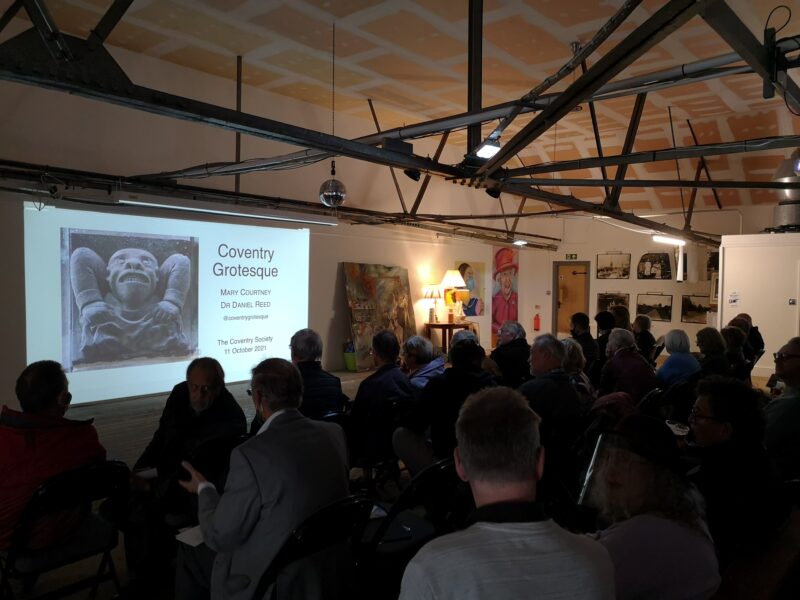
Grotesque Talk at the LTB, Coventry (October 2021). Featured: a grotesque on the Anglican Chapel at London Road Cemetery. Photography credit: Mary Courtney
HCE: What initially sparked your fascination with the grotesques?
MC: We arrived at grotesques through a fascination with elephants in Coventry. I’d been logging elephant finds on the buildings of the city for over a year and had graduated to locating birds, fish, dinosaurs, dragons and other creatures. During this process, I noticed how many animals had their tongues sticking out. How strange! This led to noticing, for the first time, the human and hybrid human tongue-sticker face carvings, which then opened a whole new grotesque world. I set about listing where they were and taking photographs on my phone.
For me, the fascination with grotesques is that they give us the full platter of weirdness, emotional expressiveness, irreverence, mischief, subversion, imagination and mystery. Best of all, they don’t reveal themselves unless you really look, they’re rarely noticed, so finding them feels like finding treasure. Bulging eyes, face-pulling, downturned mouths, foliage pouring from noses, cowering dragons, grinning skulls, the occasional exposed genitals. Their dance with the dark-side, their wit, the skills of the unsung carvers. And every one of them different. There is such an excitement to spotting them and capturing them in photographs. They make walking in Coventry an adventure. I’m completely smitten.
DR: Like Mary, I’ve long been interested in the curious, the macabre, and the otherworldly. And I’m forever pottering around historic buildings – especially churches. So, when she asked me to collaborate on a project about grotesques, there was absolutely no hesitation in saying “Yes!”
HCE: How did the two of you meet and end up collaborating?
MC: It wasn’t until I met Danny Reed through litter-picking with the Hearsall Litterbusters group that the project properly took off. I realised we both had an interest in Coventry elephants, having seen Danny’s mapping of the elephants on the bollards on Facebook. Figuring it would be a lot more enjoyable with a fellow enthusiast, I sent a text to Danny on 2nd April 2021. “Danny, do you have any interest in grotesques? I’ve been logging where they are. Would love a mapping thing to happen as per your bollards. Might it be of interest collaborating? Think it would be fun”.
His reply on the same date, which marks the official beginning of “Coventry Grotesque” was: “A chance to be obstinately pedantic with people who innocently confuse grotesques/gargoyles. Count me in. Thanks for thinking of me. Maybe one day I’ll be known as ‘the grotesque guy’”. From that moment we started Instagram: “Coventry Grotesque” and sealed the bond by going on a hunt with our phone cameras around the city centre that very weekend.
DR: My involvement with “Coventry Grotesque” has its beginnings during lockdown. I only moved to Coventry in March 2020, the same week that the first strict measures came into force – not that I knew what the following months would entail at the time! I’d been looking forward to getting to know the city better before relocating, but this suddenly became much more constrained. My daughter and I would take walks into the city centre, and she soon became fascinated by the elephant bollards. By taking notice of these pavement pachyderms, we quickly realised that there were at least two different types. This developed into a family project to map them – which, I must admit, I soon applied “Dad-like” intensity to, and began plotting their “habitat” on Google Maps. Cue some eye-rolling from my daughter! But when I shared our findings on the Sitting Rooms of Culture group on FB, we got a great response – and the rest, as they say, is history.
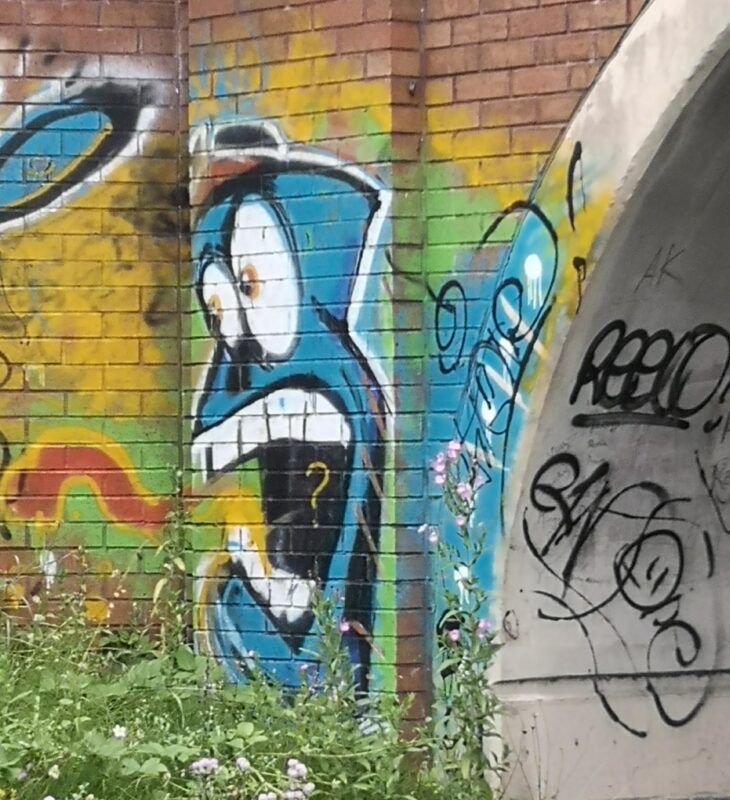
Example of modern grotesque at Coventry Canal. Photography credit: Mary Courtney.
HCE: What’s been your criteria for something to be classed as a Coventry Grotesque? The Instagram collection seems to include some contemporary entries, such as graffitied images…
DR: From the very beginning, we decided on a broad interpretation of ‘grotesque’. Though Medieval grotesques have been central to our understanding of (and enthusiasm for) our search for grotesques, the project isn’t meant to be a comprehensive architectural survey. Whilst we’ve really enjoyed delving into the historical and cultural background of these images, we’re always mindful that “Coventry Grotesque” is a creative project inspired by experiencing the city in new ways. And what was immediately apparent from our very first amble into town together was that we had an intuitive, shared understanding of what ‘grotesque’ meant to us. Be it a carving from the Middle Ages, or modern graffiti. Though we also realised that it would be easy to go mad with it! So, we developed a ‘Grotesque Taxonomy’ of six main categories to focus our attentions – and that would also draw in people particularly interested in green men, dragons, etc.
HCE: How many grotesques does Coventry have so far? Do you believe the number of discoveries will keep rising?
MC: We have around 600 images on Coventry Grotesque Instagram so far. We keep spotting more, especially since we recently expanded our range to all CV postcodes, which includes the Warwickshire area. Finds will inevitably slow down, but they aren’t showing signs of that just yet!
DR: Inevitably, there are only so many Medieval buildings in the city and local area to investigate – but there’s still plenty of scope for new discoveries. Mary and I made a pact to visit St. Mary’s Guildhall together as soon as it reopened in July 2022 after a long period of restoration – it really was the missing jigsaw piece to our explorations of the city centre. And it was worth the wait! We encountered dozens of grotesques to add to the project – it was a brilliant afternoon.
HCE: People seem to have a lot of fun hunting down and sharing images of the Grotesques. Have you been surprised by how much engagement your project has attracted?
DR: The response has been amazing. Being invited onto CWR to talk about Coventry Grotesque just a week after launching the Instagram account was a real indicator that we were onto something that captured the imagination. The great thing about using Instagram as our main platform is that anyone from around the world can find them, and we seem to have developed a loyal following. The other big success has been the digital map – which has now been viewed almost 25,000 times! We’re grateful for the support we’ve received along the way, especially from the Coventry Society and the University of Warwick.
MC: So many people have sent us images of grotesques they’ve found on their holidays as well as in the city. When I hear, “I’ve started looking up!” I can feel a huge grin spreading over my face. This involvement is what we hoped for. I’m not surprised about the interest, as they are such characters, but we’re very glad to see people noticing and enjoying them. Another big plus was the BBC online article, and coverage in the local press, which has helped spread the word.

At the LTB. Part of the top 100 local grotesques Halloween projection. Photography credit: Mary Courtney
HCE: Historically, what was the appeal of featuring grotesques in architecture – did they serve a purpose? There seem to be some competing theories, but do you guys subscribe to any in particular?
MC: For me part of the attraction of the grotesques is that their “purpose” is mysterious, they leave us guessing and wondering, always wanting to know more. Historically it was the fashion, particularly during the Medieval period. Keeping up with (or outdoing) the Joneses, had to be a key reason for their prevalence on churches and cathedrals. Ornamentation was another likely purpose. Explanations after this are simply conjecture. The more grotesques I see, the more I question the often-quoted theory of their presence being to banish evil spirits. How can the nose pickers and grinning skulls on cathedral walls frighten anything off? The more I see, the more the wit and humour of the stone masons becomes apparent. Long may they keep us guessing!
DR: Grotesques are Gothic! Meaning that they were all the rage between the twelfth and sixteenth centuries, after which they lost favour to the Mediterranean stylings and geometry of Neoclassicism. Grotesques drew from a complex visual language which (in many examples) depicted the point where the terrestrial world met the spiritual. This was a place where demons, dragons, and anything else you might imagine dwelt! But as Mary says, no one theory can effectively summarise their original purpose – but we can debunk the idea that they were private jokes of the masons, somehow contrary to Christian ideals. Even the ones baring their bums! The clergy and patrons who commissioned them knew full well what they were doing.
HCE: You must each have a few favourites Grotesques – could you introduce a few to our readers?
MC: There are three on the ruins of Coventry Cathedral which amuse me greatly. The nose-picker. For obvious reasons! Then there’s the wide-eyed face-puller, which looks both mischievous and scared. Its strange hybrid form set off with improbably tiny hands and the ears of a cat. Another favourite is the head-scratching dragon on the tower, only visible with a zoom camera or binoculars. It seems anxious, or confused and not at all scary. Some of the children I’ve shown it to have said, “It looks like he’s on a mobile!”
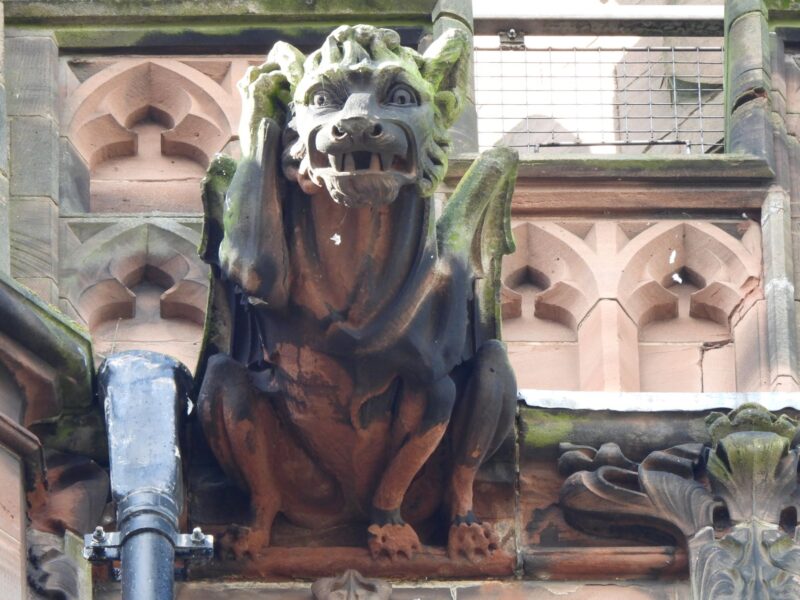
Dragon visible from the inside of Coventry Cathedral Ruins. Photography credit: Thad Williams.
There’s a grimacing character on the corner of the Anglican Chapel in London Road Cemetery that looks as if he is rapidly pulling his trousers up or down. Either way it seems such an odd thing to see on a church building that it is up there on my list of favourites.
DR: There are so many to choose from! But one that holds a special place for both of us, is the very first grotesque that we spotted on our first search together. Walking toward the city centre via Spon Street, we were still figuring out what exactly we might be looking for – when we were stopped in our tracks by a carved, wooden face leering back at us from an archway at numbers 20-21 – a bonafide Medieval survival that was relocated from Much Park Street in the 1970s. Was it an imp? Or a demon? What we were more certain about was that in the hundreds, or perhaps thousands of times that we’d collectively walked that route neither of us had noticed this creature which was now so obvious! That’s been the delight of this project. Noticing fantastical things that have seemingly been hidden in plain sight. And it’s not just us. When we gave a walking tour to the Coventry Society last summer – a group that know the built environment of the city better than anyone – none of them had seen it before either!
HCE: Can you explain to our readers what is meant by a ‘Green Man’, and where they’re most likely to spot one?
DR: To people with even a passing interest in Medieval history or British folklore, the ‘green man’ is a familiar image. They’re usually represented as a face garlanded with leaves, or with foliage spewing out of their mouths (disgorging). But some ‘green men’ aren’t men at all – they can be otherworldly creatures, or expressionless masks. Nevertheless, they’re always enigmatic, and stirring to the imagination. It’s often assumed that ‘green men’ are vestiges of a pre-Christian British culture – Pagan beliefs incorporated into the fabric of churches – but current research casts doubt on this. There’s no evidence of ‘green men’ in Britain prior to the eleventh century. This means, counterintuitively, that it is more likely that the ‘green man’ is a Christian symbol associated with the mysteries and (dis)order of nature. There are fine Medieval examples in the Marler Chapel in Holy Trinity Church, and the entrance-way to St. Mary’s Guildhall – that last one borders on the scary. Like something H. R. Giger might’ve dreamt up!
MC: There is a pub sign in Kenilworth called “The Green Man”, and a carving by Graham Jones on a tree stump in Stoke Green park, made in 2018. There are also numerous examples on the ruins of Coventry Cathedral. There is even an androgynous face on the ruins which might be a green woman. More recently, the mural on Pepper Lane in Coventry by Matt Chu, of a woman with foliage around her, could be described as a modern example of a green woman.
HCE: Do we have any idea why John Piper was so fascinated with Green Men…and do you reckon he was tempted to sneak some into Coventry Cathedral’s Baptistry Window design?
MC: John Piper had a major interest in green men, and created them in many different art forms. His gorgeous Baptistry window at Coventry Cathedral has plenty of green, though no green men, so if he was tempted to include some, he didn’t give in to it! Elsewhere is another matter. There is a decorated ceramic plate of a green man at the V and A, drawings and prints of “foliate heads” in collections at the Tate, and green men tapestries he designed at Magdalen College, Oxford. In a glass screen in a hotel in Winchester there’s also green men in stained glass. He was an avid green man hunter and church crawler himself, collaborating with John Betjamen on Shell Guide travel books and the Collins Guide to English Parish Churches (1958). It feels like we are in good company – and part of a tradition connected with Coventry.
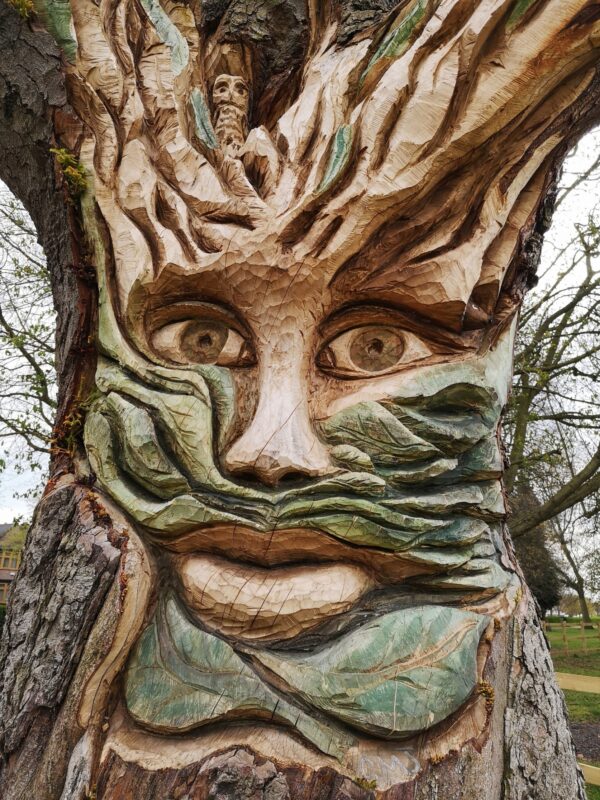
Green man carving in Stoke Green Park, Coventry. Photography credit: Mary Courtney.
HCE: Should Coventry start commissioning some new grotesque installations for future generations to find? Or would modern planning steal away some of the magic of discovering them unexpectedly?
MC: I would love to see some new grotesques in the city! Green woman and green man carvings or other grotesques such as face-pullers in the various woodlands we have in the city would be a start. There has already been a carving by Simon O’Rourke, commissioned this year. It is a story-bench, now at Tile Hill Library, with carvings of some of the Coventry legends, such as Godiva. I was asked to have input to this, and took the opportunity to include a face-puller from the ruins, which has been carved onto the bench, and his story revealed in audio when you sit down. It was a delight to have his story immortalised in one of the carvings.
A particular fantasy I have is of seeing giant, colourful, luminous images of the grotesques on the cathedral projected on the ruins at night, with a soundscape of atmospheric music. That would require major funding: definitely modern planning needed for that magic to happen!
Children’s drawings of grotesques projected large on the walls inside the new cathedral would also be ace. They are so imaginative and full of life. During the Positive Images artist residency at Coventry Central Library last summer, I ran drop-in “Making Faces” workshops, inspired by images of grotesques on our buildings. 380 people joined in, and showed that it would be easy enough to get a fabulous bank of new grotesque images together, Coventry-made.
HCE: Your LTB exhibition in 2021 was a success and your digital map is going strong – are there plans for any further Grotesque projects, or will you be letting them all lurk in peace for a while?
MC: An aspiration for the coming year is a “Coventry Grotesque” book. There is no such thing in existence for our city. Oxford has its own grotesque book, covering their carvings in the city, and we would like to see this provision for Coventry too, but with our own creative interpretation of grotesque and lots of fantastic pictures! We will be on the lookout for a publisher.
Another possibility for the future is to extend the animations Josh Leach and myself have made together. (We’ve shown our cartoon grotesques already at the LTB). If we held a free animation club, then we could share the new grotesque creations, with the double whammy of building animation skills in Coventry and spreading the love of grotesques.
At some point in the future I would like to collaborate on making a giant glamorous green woman out of bling or re-purposed rubbish.
For Halloween this autumn, we will do something lurking in the shadows. It will be a surprise. Watch out!
Any links/social media you’d like to plug here:
Mary and Danny’s grotesque guide to Coventry (and beyond) can be viewed here. Use the map to visit the city virtually or in-person to track down as many of the listed grotesques as you can, and see if you discover any new ones yourself!
Click on an icon to bring up a photo and notes on its whereabouts. Zoom in-and-out of the map either using your mouse, or the + and – buttons in the bottom-left of the map. Mobile users: click on an icon to open a white category bar at the bottom of your screen (e.g. ‘Grimacing Grotesques’).
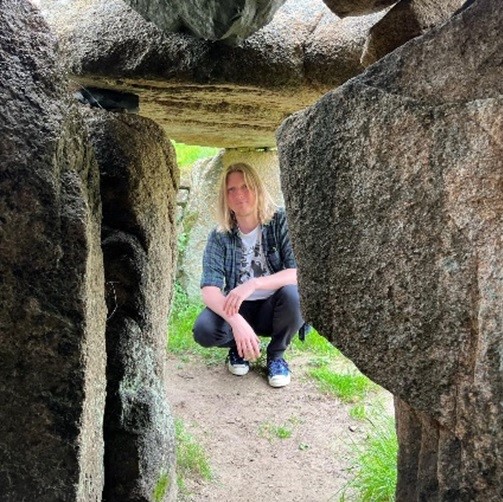
Trail-mapper Dr Daniel Reed is an historical researcher with interests in British social and religious history in the long eighteenth century. His published work has primarily been in the fields of religious and print history. Daniel has developed the digital resources, ‘British Methodist Buildings’ and ‘Methodist Portrait Prints’ for the Oxford Centre for Methodism and Church History. He has also been an active member of the International Laurence Sterne Foundation since its inception in 2013, and has acted as Assistant Editor to ‘The Shandean’ since 2016.

Coventry’s Mary Courtney is an award-winning artist and poet…and an avid grotesque hunter. At home in various modes and media, Mary moves fluidly between drawing, animation, word-play, collaborative filmmaking and installation. She takes inspiration from her city, stories, science, the ambiguous and deliciously ridiculous, and collaborates with artists and people of all ages and walks of life. During the Covid-19 lockdowns, she co-founded Sitting Rooms of Culture, a Facebook community with over six thousand members, to support and showcase creativity in Coventry. Among her many accomplishments, Mary has made a drawing the size of two and a half blue whales, a poetry bridge and a talking tin of tomatoes.
